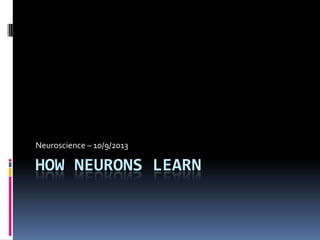
Neurons, Learning, and Dopamine
- 1. HOW NEURONS LEARN Neuroscience – 10/9/2013
- 2. What is learning? Take a few moments and produce your own definition of what learning is. Consider— What kinds of things do you learn? How do you learn them?
- 3. Different Domains of Learning COGNITIVE Facts and information Procedures (how to solve a problem) PSYCHOMOTOR Physical patterns of activity AFFECTIVE Learning to “feel” something
- 4. Write your own example of: Cognitive Learning Psychomotor Learning Affective Learning What do these types of learning have in common?
- 5. My brain, pre learning: STIMULUS 1 RESPONSE 1 (Shakespearean sonnet) (ennui) My brain, post learning: STIMULUS 1 RESPONSE 2!!!!! (Shakespearean sonnet) (happiness!) Learning is the association of stimuli with new responses.
- 6. How does learning occur? Our brain has about a hundred billion neurons, but we do not grow new ones (mostly) Instead , learning happens at the connection point between different neurons—at the synapse.
- 7. How can neurons change? Growing longer dendrites/axons to make new synapses Releasing more vesicles of neurotransmitter (presynaptic cell) More receptors for neurotransmitter (postsynaptic cell)
- 8. In this picture, there are 3 things happening to strengthen this synapse. Can you find them?
- 10. Dopamine Dopamine is a particular neurotransmitter with many roles in the brain, including: - Cardiovascular and renal control - Movement and balance - Reward and addiction - Pleasure, emotion - Normal cognitive function (thinking)
- 12. Dopamine and disease Dopamine deficiency in certain parts of the brain is related to Parkinson’s and motion disorder. Excessive dopamine has been linked to schizophrenia and delusions.
- 13. Mechanisms of Drug Action A dopamine agonist would bind to receptors instead of dopamine and convince your neurons that dopamine was there. A dopamine antagonist would bind to receptors instead of dopamine and block normal activation. Other drugs inhibit reuptake, leaving more dopamine in the synapse longer. (cocaine) Indirect drugs cause extra dopamine release from all neurons (amphetamine)
- 14. Neurotransmitters convey “messages” across the synapse
- 16. Dopamine and Reward Dopamine is involved in a brain circuit often called the “reward pathway” In studies, we observe dopamine release when subjects are rewarded with food/money/etc Generally, more dopamine is released when the reward is unpredicted
- 17. Dopamine/Opioids: Brain’s incentive reward systems
- 18. Activation of reward center produces a “wanting” and “liking” response
- 19. Natural events activate these reward systems
- 20. 0 50 100 150 200 0 60 120 180 Time (min) %ofBasalDAOutput NAc shell Empty Box Feeding DiChiara et al., Neuroscience, 1999. FOOD Mounts Intromissions Ejaculations Fiorino and Phillips,J. Neuroscience, 1997. Natural Events Elevate Dopamine Levels 100 150 200 DAConcentration(%Baseline) 15 0 5 10 CopulationFrequency Sample Number 1 2 3 4 5 6 7 8 SEX Female Present
- 21. Some drugs activate your reward systems since they act on the same receptors
- 22. Drugs make your brain really happy….. Normal Brain Brain on Drugs BUT only when your brain is on drugs.
- 23. 0 100 200 300 400 500 600 700 800 900 1000 1100 0 1 2 3 4 5 hr Time After Amphetamine %ofBasalRelease DA DOPAC HVA Accumbens AMPHETAMINE 0 100 200 300 400 0 1 2 3 4 5 hr Time After Cocaine %ofBasalRelease DA DOPAC HVA Accumbens COCAINE 0 100 150 200 250 0 1 2 3 4 5hr Time After Morphine %ofBasalRelease Accumbens 0.5 1.0 2.5 10 Dose (mg/kg) MORPHINE 0 100 150 200 250 0 1 2 3 hr Time After Nicotine %ofBasalRelease Accumbens Caudate NICOTINE DiChiara and Imperato, PNAS, 1988 Effects of Drugs on Dopamine Release
- 24. Repeated use of drugs trigger compensatory processes and saturate the brain’s reward systems individual can become conditioned/habituated/adapted to the intense level of drug-induced pleasure the normal level of natural rewards are no longer experienced as very pleasurable this is caused by synaptic changes—just like learning!
- 25. Upregulation Downregulation Too much dopamine activation at the synapses leads your neurons to decrease the number of receptors.
- 26. Brain on drugs after tolerance Brain on drugs for an extended period Chronic drug taking ….reorganizes the liking and wanting systems … drugs may no longer be pleasurable but you still want them…
- 27. Drugs can change your brain so that natural events are no longer pleasurable
- 28. high low High DA receptor Low DA receptor DA Receptors and the Response to Methylphenidate (MP) As a group, subjects with low receptor levels found MP pleasant while those with high levels found MP unpleasant Adapted from Volkow et al., Am. J. Psychiatry, 1999. Dopaminereceptorlevel
